Assessment 3 Report: Augmented Reality for Education at XYZ
VerifiedAdded on 2020/11/23
|12
|3710
|303
Report
AI Summary
This report, prepared for XYZ University by an IT consultancy, analyzes the application of Augmented Reality (AR) in the education sector. It begins with an executive summary and introduction, defining AR and outlining its current developments and industry applications. The report then focuses on how AR can enhance student learning, exploring the implementation of AR in classrooms, augmented reality enabled worksheets, and AR applications for students. It discusses the advantages and disadvantages of AR in education, as well as the necessary hardware requirements. The report critically analyzes how AR can meet XYZ University's goals, including its use as a marketing tool, and addresses potential advantages, disadvantages, costs, and ethical considerations. The report concludes with recommendations and a summary of the findings, supported by references to relevant research.
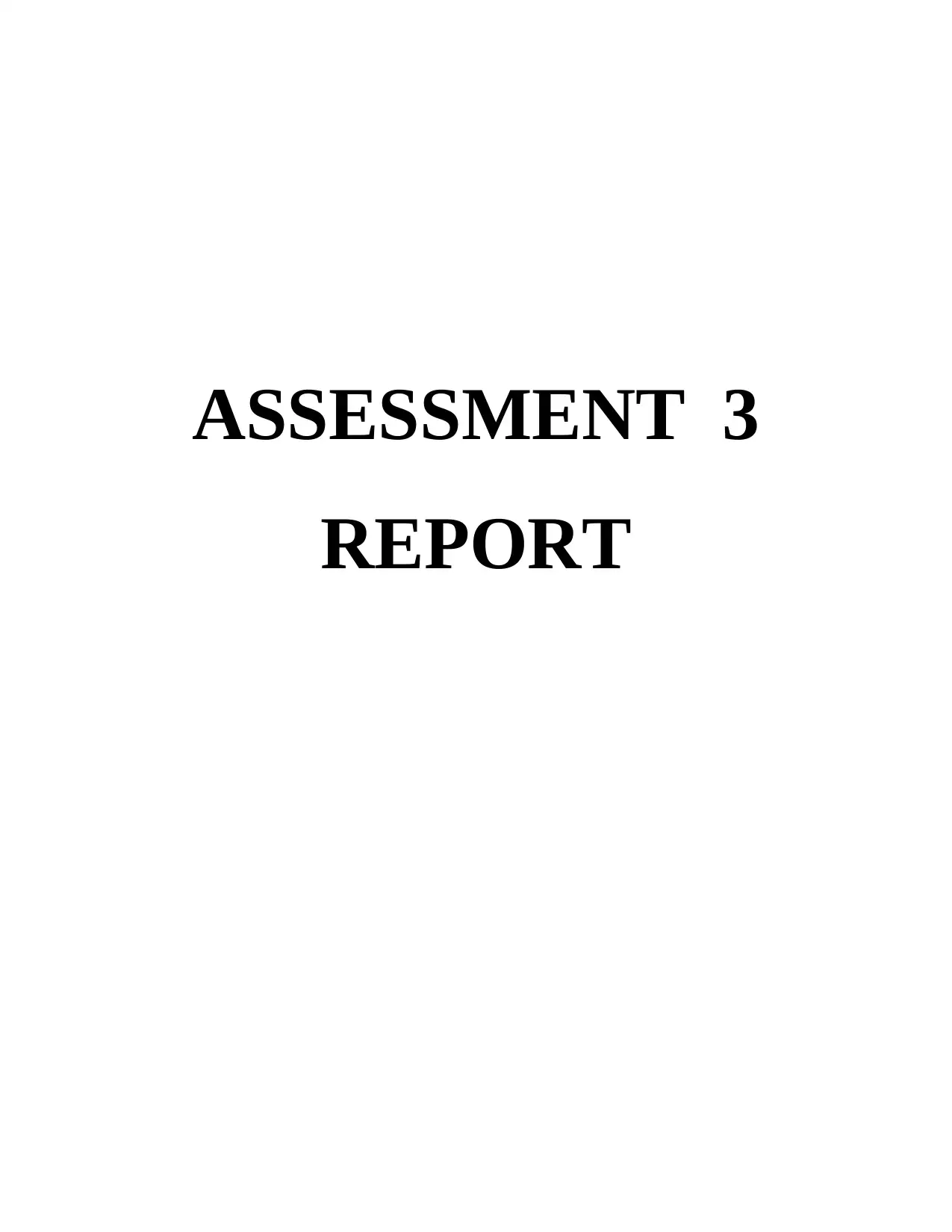
ASSESSMENT 3
REPORT
REPORT
Paraphrase This Document
Need a fresh take? Get an instant paraphrase of this document with our AI Paraphraser
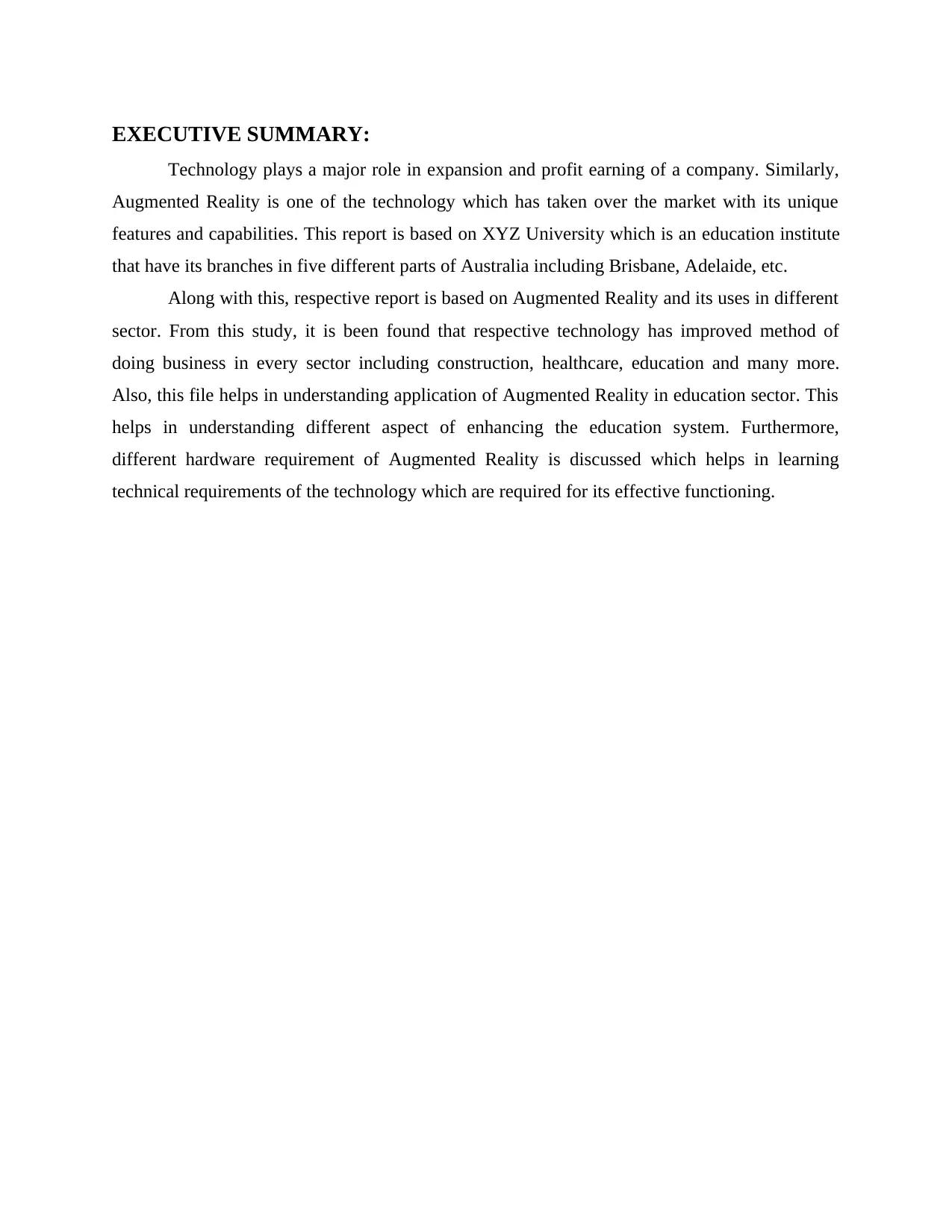
EXECUTIVE SUMMARY:
Technology plays a major role in expansion and profit earning of a company. Similarly,
Augmented Reality is one of the technology which has taken over the market with its unique
features and capabilities. This report is based on XYZ University which is an education institute
that have its branches in five different parts of Australia including Brisbane, Adelaide, etc.
Along with this, respective report is based on Augmented Reality and its uses in different
sector. From this study, it is been found that respective technology has improved method of
doing business in every sector including construction, healthcare, education and many more.
Also, this file helps in understanding application of Augmented Reality in education sector. This
helps in understanding different aspect of enhancing the education system. Furthermore,
different hardware requirement of Augmented Reality is discussed which helps in learning
technical requirements of the technology which are required for its effective functioning.
Technology plays a major role in expansion and profit earning of a company. Similarly,
Augmented Reality is one of the technology which has taken over the market with its unique
features and capabilities. This report is based on XYZ University which is an education institute
that have its branches in five different parts of Australia including Brisbane, Adelaide, etc.
Along with this, respective report is based on Augmented Reality and its uses in different
sector. From this study, it is been found that respective technology has improved method of
doing business in every sector including construction, healthcare, education and many more.
Also, this file helps in understanding application of Augmented Reality in education sector. This
helps in understanding different aspect of enhancing the education system. Furthermore,
different hardware requirement of Augmented Reality is discussed which helps in learning
technical requirements of the technology which are required for its effective functioning.
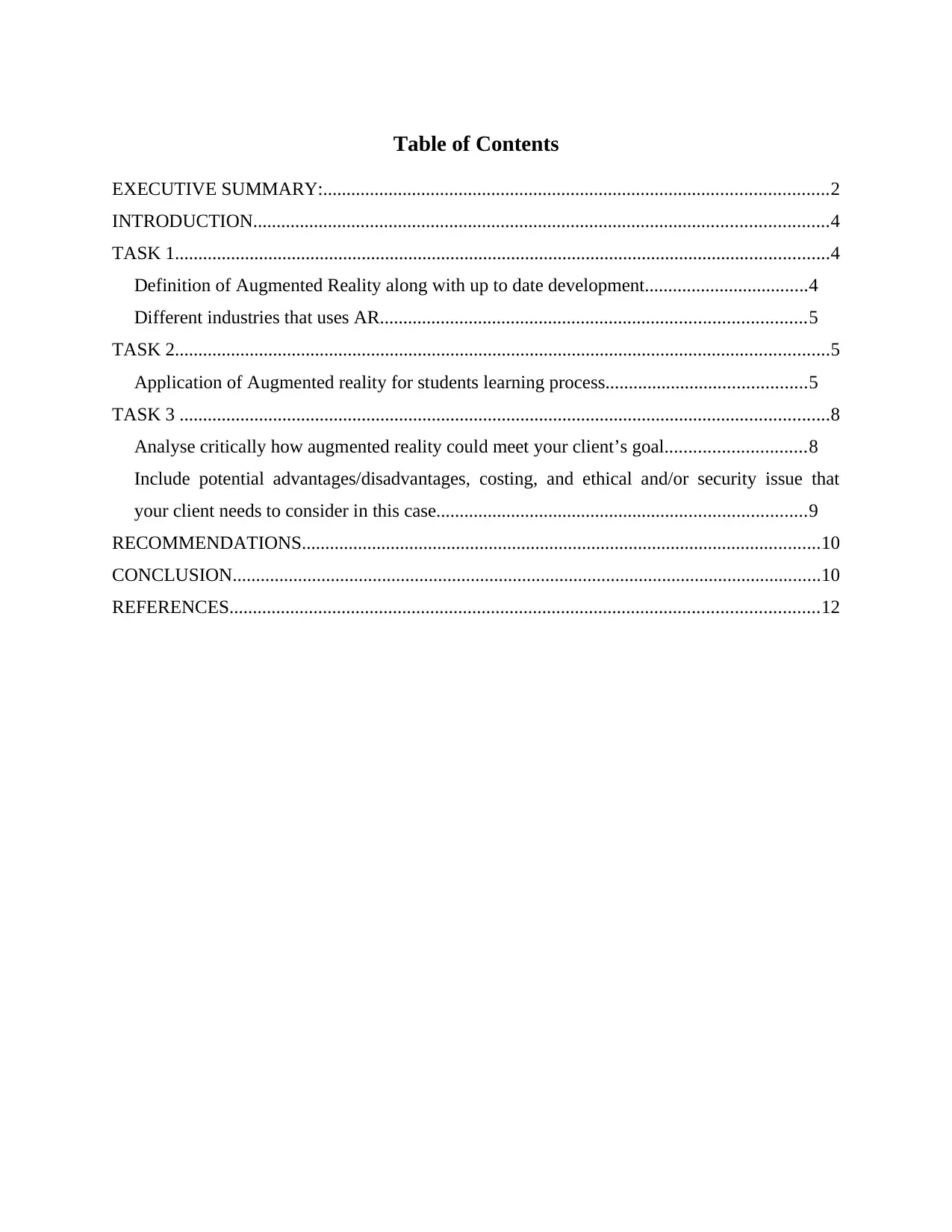
Table of Contents
EXECUTIVE SUMMARY:............................................................................................................2
INTRODUCTION...........................................................................................................................4
TASK 1............................................................................................................................................4
Definition of Augmented Reality along with up to date development...................................4
Different industries that uses AR...........................................................................................5
TASK 2............................................................................................................................................5
Application of Augmented reality for students learning process...........................................5
TASK 3 ...........................................................................................................................................8
Analyse critically how augmented reality could meet your client’s goal..............................8
Include potential advantages/disadvantages, costing, and ethical and/or security issue that
your client needs to consider in this case...............................................................................9
RECOMMENDATIONS...............................................................................................................10
CONCLUSION..............................................................................................................................10
REFERENCES..............................................................................................................................12
EXECUTIVE SUMMARY:............................................................................................................2
INTRODUCTION...........................................................................................................................4
TASK 1............................................................................................................................................4
Definition of Augmented Reality along with up to date development...................................4
Different industries that uses AR...........................................................................................5
TASK 2............................................................................................................................................5
Application of Augmented reality for students learning process...........................................5
TASK 3 ...........................................................................................................................................8
Analyse critically how augmented reality could meet your client’s goal..............................8
Include potential advantages/disadvantages, costing, and ethical and/or security issue that
your client needs to consider in this case...............................................................................9
RECOMMENDATIONS...............................................................................................................10
CONCLUSION..............................................................................................................................10
REFERENCES..............................................................................................................................12
⊘ This is a preview!⊘
Do you want full access?
Subscribe today to unlock all pages.

Trusted by 1+ million students worldwide
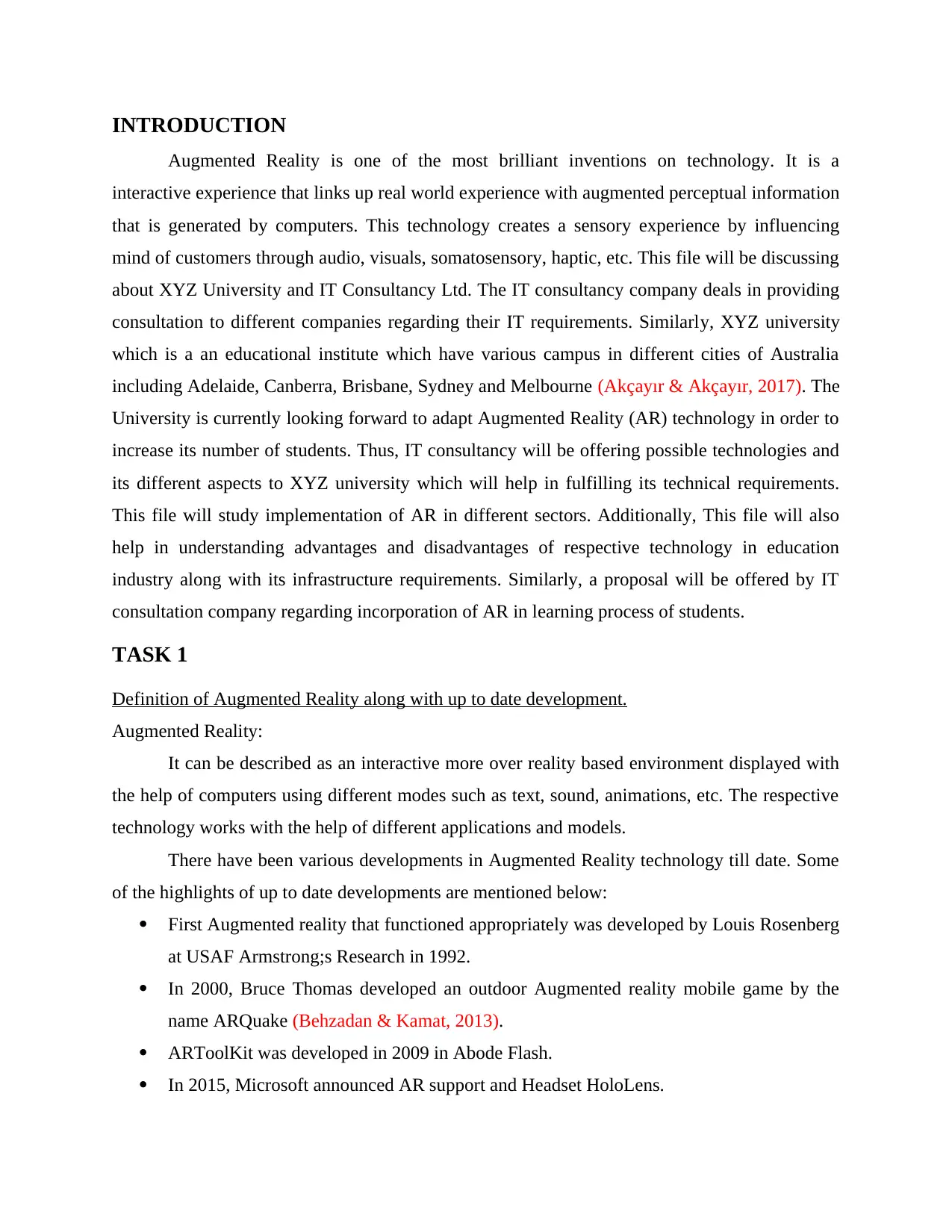
INTRODUCTION
Augmented Reality is one of the most brilliant inventions on technology. It is a
interactive experience that links up real world experience with augmented perceptual information
that is generated by computers. This technology creates a sensory experience by influencing
mind of customers through audio, visuals, somatosensory, haptic, etc. This file will be discussing
about XYZ University and IT Consultancy Ltd. The IT consultancy company deals in providing
consultation to different companies regarding their IT requirements. Similarly, XYZ university
which is a an educational institute which have various campus in different cities of Australia
including Adelaide, Canberra, Brisbane, Sydney and Melbourne (Akçayır & Akçayır, 2017). The
University is currently looking forward to adapt Augmented Reality (AR) technology in order to
increase its number of students. Thus, IT consultancy will be offering possible technologies and
its different aspects to XYZ university which will help in fulfilling its technical requirements.
This file will study implementation of AR in different sectors. Additionally, This file will also
help in understanding advantages and disadvantages of respective technology in education
industry along with its infrastructure requirements. Similarly, a proposal will be offered by IT
consultation company regarding incorporation of AR in learning process of students.
TASK 1
Definition of Augmented Reality along with up to date development.
Augmented Reality:
It can be described as an interactive more over reality based environment displayed with
the help of computers using different modes such as text, sound, animations, etc. The respective
technology works with the help of different applications and models.
There have been various developments in Augmented Reality technology till date. Some
of the highlights of up to date developments are mentioned below:
First Augmented reality that functioned appropriately was developed by Louis Rosenberg
at USAF Armstrong;s Research in 1992.
In 2000, Bruce Thomas developed an outdoor Augmented reality mobile game by the
name ARQuake (Behzadan & Kamat, 2013).
ARToolKit was developed in 2009 in Abode Flash.
In 2015, Microsoft announced AR support and Headset HoloLens.
Augmented Reality is one of the most brilliant inventions on technology. It is a
interactive experience that links up real world experience with augmented perceptual information
that is generated by computers. This technology creates a sensory experience by influencing
mind of customers through audio, visuals, somatosensory, haptic, etc. This file will be discussing
about XYZ University and IT Consultancy Ltd. The IT consultancy company deals in providing
consultation to different companies regarding their IT requirements. Similarly, XYZ university
which is a an educational institute which have various campus in different cities of Australia
including Adelaide, Canberra, Brisbane, Sydney and Melbourne (Akçayır & Akçayır, 2017). The
University is currently looking forward to adapt Augmented Reality (AR) technology in order to
increase its number of students. Thus, IT consultancy will be offering possible technologies and
its different aspects to XYZ university which will help in fulfilling its technical requirements.
This file will study implementation of AR in different sectors. Additionally, This file will also
help in understanding advantages and disadvantages of respective technology in education
industry along with its infrastructure requirements. Similarly, a proposal will be offered by IT
consultation company regarding incorporation of AR in learning process of students.
TASK 1
Definition of Augmented Reality along with up to date development.
Augmented Reality:
It can be described as an interactive more over reality based environment displayed with
the help of computers using different modes such as text, sound, animations, etc. The respective
technology works with the help of different applications and models.
There have been various developments in Augmented Reality technology till date. Some
of the highlights of up to date developments are mentioned below:
First Augmented reality that functioned appropriately was developed by Louis Rosenberg
at USAF Armstrong;s Research in 1992.
In 2000, Bruce Thomas developed an outdoor Augmented reality mobile game by the
name ARQuake (Behzadan & Kamat, 2013).
ARToolKit was developed in 2009 in Abode Flash.
In 2015, Microsoft announced AR support and Headset HoloLens.
Paraphrase This Document
Need a fresh take? Get an instant paraphrase of this document with our AI Paraphraser
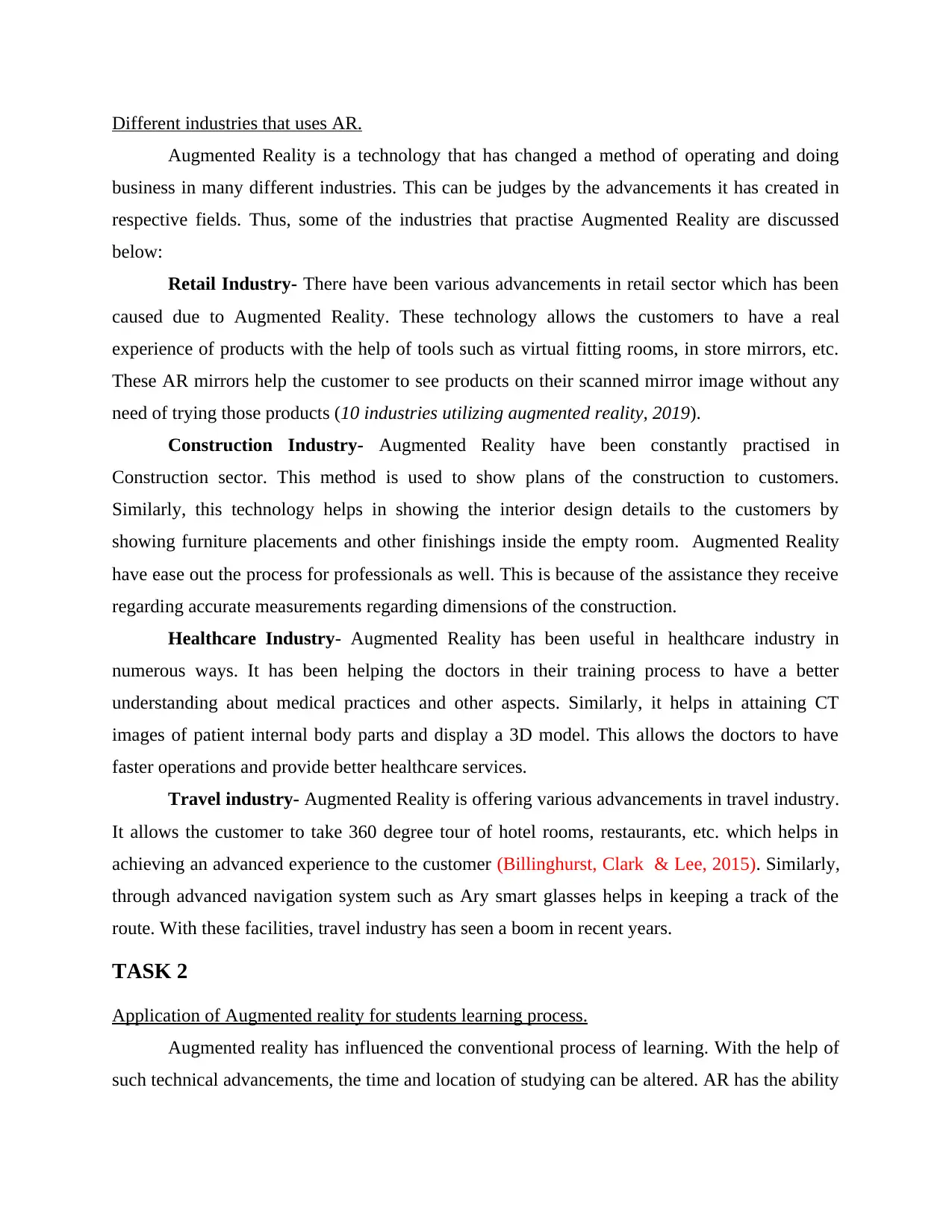
Different industries that uses AR.
Augmented Reality is a technology that has changed a method of operating and doing
business in many different industries. This can be judges by the advancements it has created in
respective fields. Thus, some of the industries that practise Augmented Reality are discussed
below:
Retail Industry- There have been various advancements in retail sector which has been
caused due to Augmented Reality. These technology allows the customers to have a real
experience of products with the help of tools such as virtual fitting rooms, in store mirrors, etc.
These AR mirrors help the customer to see products on their scanned mirror image without any
need of trying those products (10 industries utilizing augmented reality, 2019).
Construction Industry- Augmented Reality have been constantly practised in
Construction sector. This method is used to show plans of the construction to customers.
Similarly, this technology helps in showing the interior design details to the customers by
showing furniture placements and other finishings inside the empty room. Augmented Reality
have ease out the process for professionals as well. This is because of the assistance they receive
regarding accurate measurements regarding dimensions of the construction.
Healthcare Industry- Augmented Reality has been useful in healthcare industry in
numerous ways. It has been helping the doctors in their training process to have a better
understanding about medical practices and other aspects. Similarly, it helps in attaining CT
images of patient internal body parts and display a 3D model. This allows the doctors to have
faster operations and provide better healthcare services.
Travel industry- Augmented Reality is offering various advancements in travel industry.
It allows the customer to take 360 degree tour of hotel rooms, restaurants, etc. which helps in
achieving an advanced experience to the customer (Billinghurst, Clark & Lee, 2015). Similarly,
through advanced navigation system such as Ary smart glasses helps in keeping a track of the
route. With these facilities, travel industry has seen a boom in recent years.
TASK 2
Application of Augmented reality for students learning process.
Augmented reality has influenced the conventional process of learning. With the help of
such technical advancements, the time and location of studying can be altered. AR has the ability
Augmented Reality is a technology that has changed a method of operating and doing
business in many different industries. This can be judges by the advancements it has created in
respective fields. Thus, some of the industries that practise Augmented Reality are discussed
below:
Retail Industry- There have been various advancements in retail sector which has been
caused due to Augmented Reality. These technology allows the customers to have a real
experience of products with the help of tools such as virtual fitting rooms, in store mirrors, etc.
These AR mirrors help the customer to see products on their scanned mirror image without any
need of trying those products (10 industries utilizing augmented reality, 2019).
Construction Industry- Augmented Reality have been constantly practised in
Construction sector. This method is used to show plans of the construction to customers.
Similarly, this technology helps in showing the interior design details to the customers by
showing furniture placements and other finishings inside the empty room. Augmented Reality
have ease out the process for professionals as well. This is because of the assistance they receive
regarding accurate measurements regarding dimensions of the construction.
Healthcare Industry- Augmented Reality has been useful in healthcare industry in
numerous ways. It has been helping the doctors in their training process to have a better
understanding about medical practices and other aspects. Similarly, it helps in attaining CT
images of patient internal body parts and display a 3D model. This allows the doctors to have
faster operations and provide better healthcare services.
Travel industry- Augmented Reality is offering various advancements in travel industry.
It allows the customer to take 360 degree tour of hotel rooms, restaurants, etc. which helps in
achieving an advanced experience to the customer (Billinghurst, Clark & Lee, 2015). Similarly,
through advanced navigation system such as Ary smart glasses helps in keeping a track of the
route. With these facilities, travel industry has seen a boom in recent years.
TASK 2
Application of Augmented reality for students learning process.
Augmented reality has influenced the conventional process of learning. With the help of
such technical advancements, the time and location of studying can be altered. AR has the ability
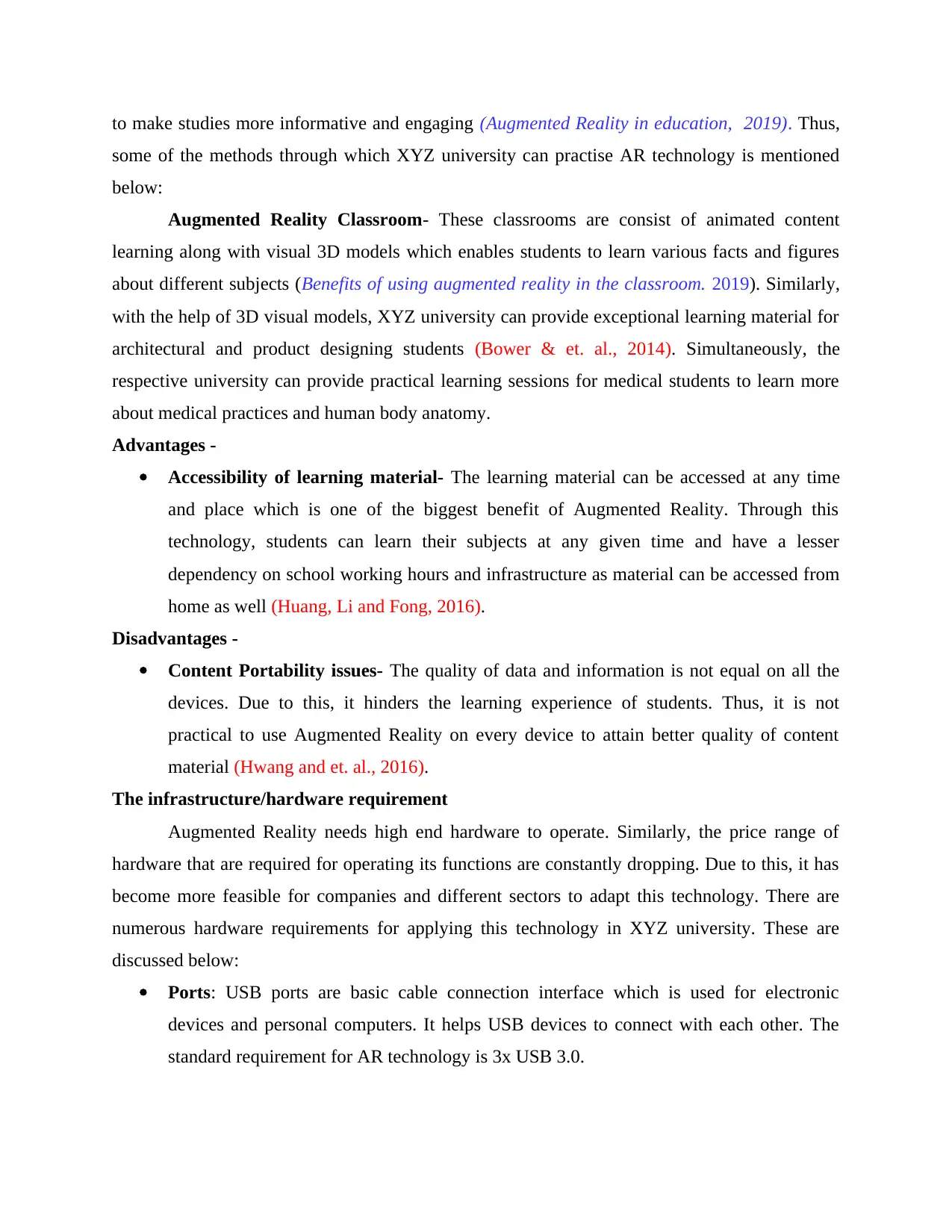
to make studies more informative and engaging (Augmented Reality in education, 2019). Thus,
some of the methods through which XYZ university can practise AR technology is mentioned
below:
Augmented Reality Classroom- These classrooms are consist of animated content
learning along with visual 3D models which enables students to learn various facts and figures
about different subjects (Benefits of using augmented reality in the classroom. 2019). Similarly,
with the help of 3D visual models, XYZ university can provide exceptional learning material for
architectural and product designing students (Bower & et. al., 2014). Simultaneously, the
respective university can provide practical learning sessions for medical students to learn more
about medical practices and human body anatomy.
Advantages -
Accessibility of learning material- The learning material can be accessed at any time
and place which is one of the biggest benefit of Augmented Reality. Through this
technology, students can learn their subjects at any given time and have a lesser
dependency on school working hours and infrastructure as material can be accessed from
home as well (Huang, Li and Fong, 2016).
Disadvantages -
Content Portability issues- The quality of data and information is not equal on all the
devices. Due to this, it hinders the learning experience of students. Thus, it is not
practical to use Augmented Reality on every device to attain better quality of content
material (Hwang and et. al., 2016).
The infrastructure/hardware requirement
Augmented Reality needs high end hardware to operate. Similarly, the price range of
hardware that are required for operating its functions are constantly dropping. Due to this, it has
become more feasible for companies and different sectors to adapt this technology. There are
numerous hardware requirements for applying this technology in XYZ university. These are
discussed below:
Ports: USB ports are basic cable connection interface which is used for electronic
devices and personal computers. It helps USB devices to connect with each other. The
standard requirement for AR technology is 3x USB 3.0.
some of the methods through which XYZ university can practise AR technology is mentioned
below:
Augmented Reality Classroom- These classrooms are consist of animated content
learning along with visual 3D models which enables students to learn various facts and figures
about different subjects (Benefits of using augmented reality in the classroom. 2019). Similarly,
with the help of 3D visual models, XYZ university can provide exceptional learning material for
architectural and product designing students (Bower & et. al., 2014). Simultaneously, the
respective university can provide practical learning sessions for medical students to learn more
about medical practices and human body anatomy.
Advantages -
Accessibility of learning material- The learning material can be accessed at any time
and place which is one of the biggest benefit of Augmented Reality. Through this
technology, students can learn their subjects at any given time and have a lesser
dependency on school working hours and infrastructure as material can be accessed from
home as well (Huang, Li and Fong, 2016).
Disadvantages -
Content Portability issues- The quality of data and information is not equal on all the
devices. Due to this, it hinders the learning experience of students. Thus, it is not
practical to use Augmented Reality on every device to attain better quality of content
material (Hwang and et. al., 2016).
The infrastructure/hardware requirement
Augmented Reality needs high end hardware to operate. Similarly, the price range of
hardware that are required for operating its functions are constantly dropping. Due to this, it has
become more feasible for companies and different sectors to adapt this technology. There are
numerous hardware requirements for applying this technology in XYZ university. These are
discussed below:
Ports: USB ports are basic cable connection interface which is used for electronic
devices and personal computers. It helps USB devices to connect with each other. The
standard requirement for AR technology is 3x USB 3.0.
⊘ This is a preview!⊘
Do you want full access?
Subscribe today to unlock all pages.

Trusted by 1+ million students worldwide
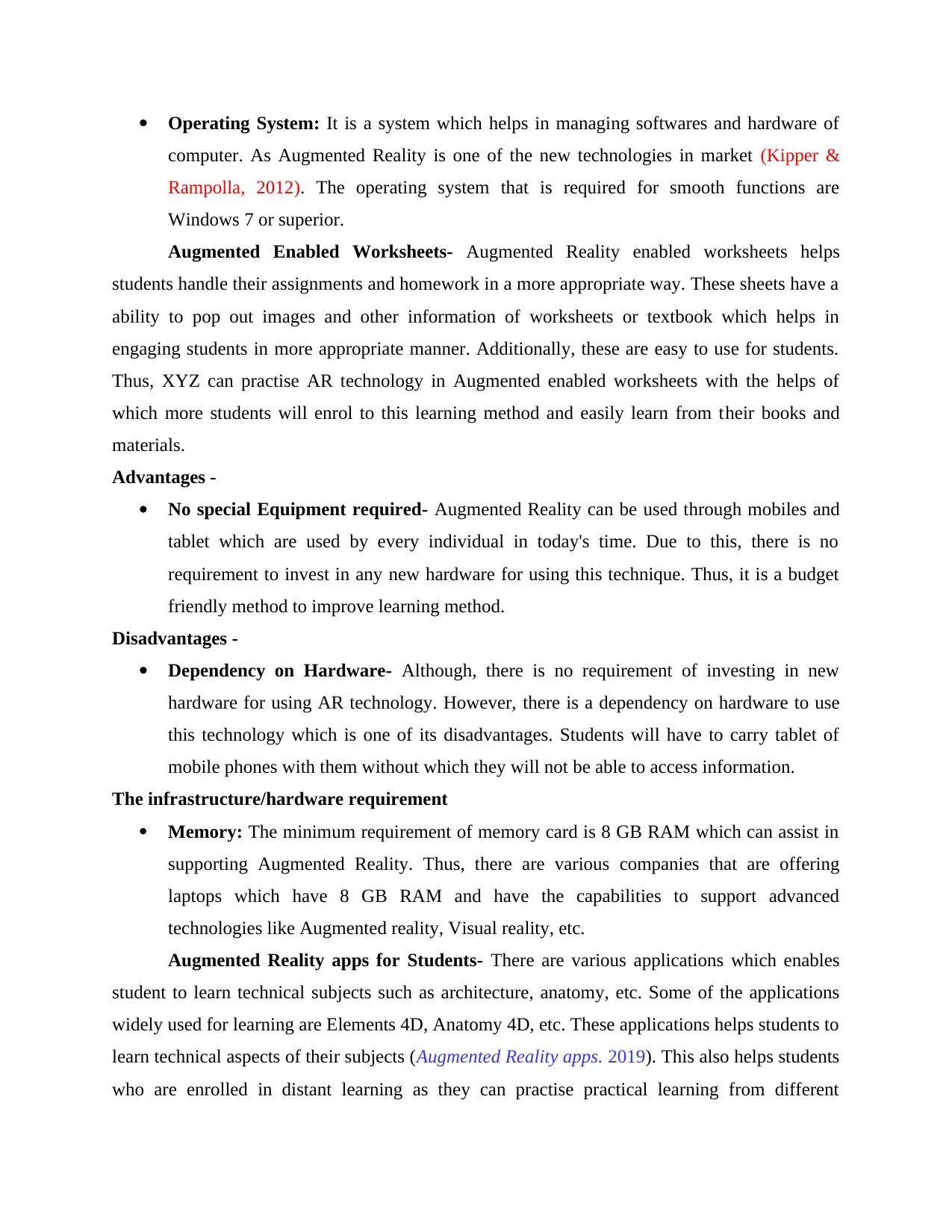
Operating System: It is a system which helps in managing softwares and hardware of
computer. As Augmented Reality is one of the new technologies in market (Kipper &
Rampolla, 2012). The operating system that is required for smooth functions are
Windows 7 or superior.
Augmented Enabled Worksheets- Augmented Reality enabled worksheets helps
students handle their assignments and homework in a more appropriate way. These sheets have a
ability to pop out images and other information of worksheets or textbook which helps in
engaging students in more appropriate manner. Additionally, these are easy to use for students.
Thus, XYZ can practise AR technology in Augmented enabled worksheets with the helps of
which more students will enrol to this learning method and easily learn from their books and
materials.
Advantages -
No special Equipment required- Augmented Reality can be used through mobiles and
tablet which are used by every individual in today's time. Due to this, there is no
requirement to invest in any new hardware for using this technique. Thus, it is a budget
friendly method to improve learning method.
Disadvantages -
Dependency on Hardware- Although, there is no requirement of investing in new
hardware for using AR technology. However, there is a dependency on hardware to use
this technology which is one of its disadvantages. Students will have to carry tablet of
mobile phones with them without which they will not be able to access information.
The infrastructure/hardware requirement
Memory: The minimum requirement of memory card is 8 GB RAM which can assist in
supporting Augmented Reality. Thus, there are various companies that are offering
laptops which have 8 GB RAM and have the capabilities to support advanced
technologies like Augmented reality, Visual reality, etc.
Augmented Reality apps for Students- There are various applications which enables
student to learn technical subjects such as architecture, anatomy, etc. Some of the applications
widely used for learning are Elements 4D, Anatomy 4D, etc. These applications helps students to
learn technical aspects of their subjects (Augmented Reality apps. 2019). This also helps students
who are enrolled in distant learning as they can practise practical learning from different
computer. As Augmented Reality is one of the new technologies in market (Kipper &
Rampolla, 2012). The operating system that is required for smooth functions are
Windows 7 or superior.
Augmented Enabled Worksheets- Augmented Reality enabled worksheets helps
students handle their assignments and homework in a more appropriate way. These sheets have a
ability to pop out images and other information of worksheets or textbook which helps in
engaging students in more appropriate manner. Additionally, these are easy to use for students.
Thus, XYZ can practise AR technology in Augmented enabled worksheets with the helps of
which more students will enrol to this learning method and easily learn from their books and
materials.
Advantages -
No special Equipment required- Augmented Reality can be used through mobiles and
tablet which are used by every individual in today's time. Due to this, there is no
requirement to invest in any new hardware for using this technique. Thus, it is a budget
friendly method to improve learning method.
Disadvantages -
Dependency on Hardware- Although, there is no requirement of investing in new
hardware for using AR technology. However, there is a dependency on hardware to use
this technology which is one of its disadvantages. Students will have to carry tablet of
mobile phones with them without which they will not be able to access information.
The infrastructure/hardware requirement
Memory: The minimum requirement of memory card is 8 GB RAM which can assist in
supporting Augmented Reality. Thus, there are various companies that are offering
laptops which have 8 GB RAM and have the capabilities to support advanced
technologies like Augmented reality, Visual reality, etc.
Augmented Reality apps for Students- There are various applications which enables
student to learn technical subjects such as architecture, anatomy, etc. Some of the applications
widely used for learning are Elements 4D, Anatomy 4D, etc. These applications helps students to
learn technical aspects of their subjects (Augmented Reality apps. 2019). This also helps students
who are enrolled in distant learning as they can practise practical learning from different
Paraphrase This Document
Need a fresh take? Get an instant paraphrase of this document with our AI Paraphraser
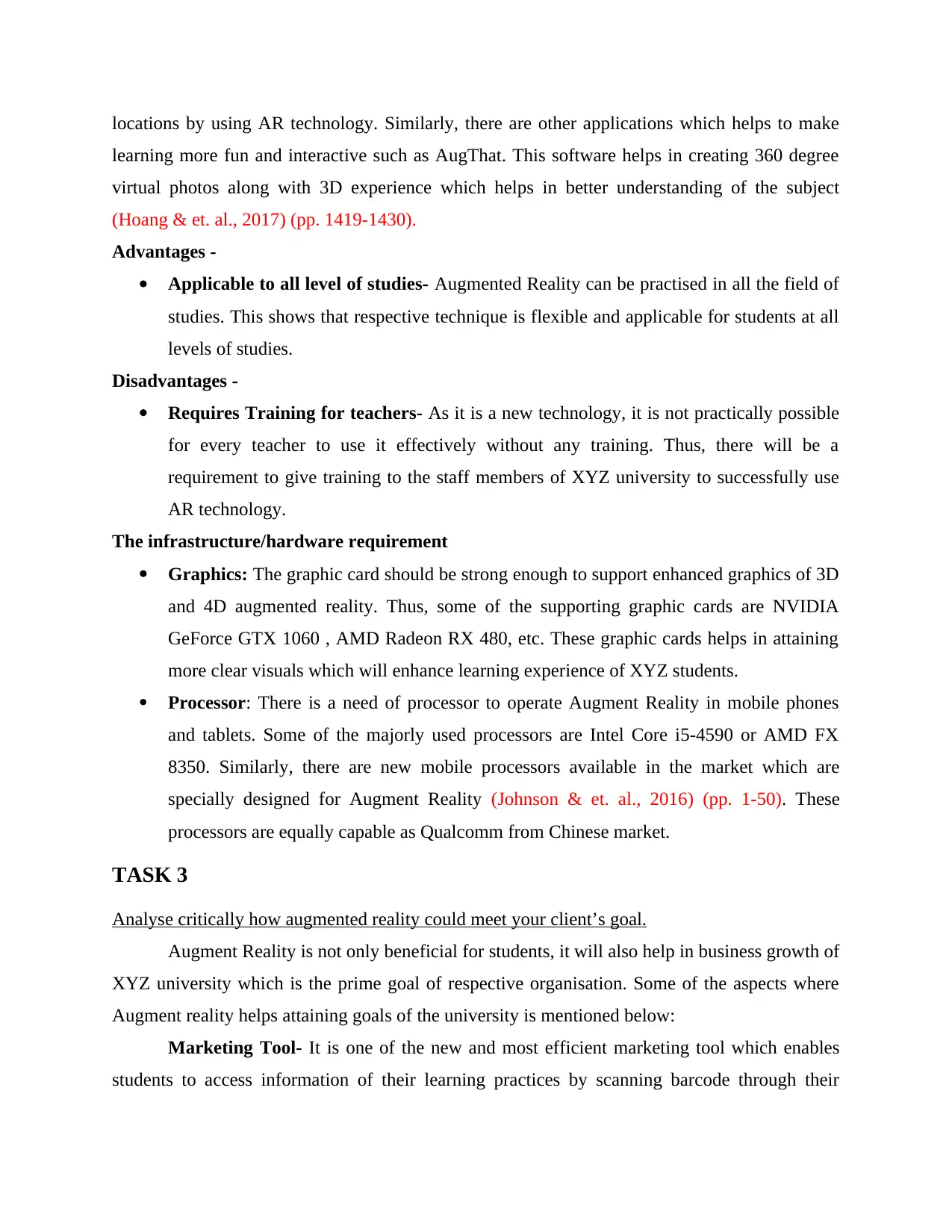
locations by using AR technology. Similarly, there are other applications which helps to make
learning more fun and interactive such as AugThat. This software helps in creating 360 degree
virtual photos along with 3D experience which helps in better understanding of the subject
(Hoang & et. al., 2017) (pp. 1419-1430).
Advantages -
Applicable to all level of studies- Augmented Reality can be practised in all the field of
studies. This shows that respective technique is flexible and applicable for students at all
levels of studies.
Disadvantages -
Requires Training for teachers- As it is a new technology, it is not practically possible
for every teacher to use it effectively without any training. Thus, there will be a
requirement to give training to the staff members of XYZ university to successfully use
AR technology.
The infrastructure/hardware requirement
Graphics: The graphic card should be strong enough to support enhanced graphics of 3D
and 4D augmented reality. Thus, some of the supporting graphic cards are NVIDIA
GeForce GTX 1060 , AMD Radeon RX 480, etc. These graphic cards helps in attaining
more clear visuals which will enhance learning experience of XYZ students.
Processor: There is a need of processor to operate Augment Reality in mobile phones
and tablets. Some of the majorly used processors are Intel Core i5-4590 or AMD FX
8350. Similarly, there are new mobile processors available in the market which are
specially designed for Augment Reality (Johnson & et. al., 2016) (pp. 1-50). These
processors are equally capable as Qualcomm from Chinese market.
TASK 3
Analyse critically how augmented reality could meet your client’s goal.
Augment Reality is not only beneficial for students, it will also help in business growth of
XYZ university which is the prime goal of respective organisation. Some of the aspects where
Augment reality helps attaining goals of the university is mentioned below:
Marketing Tool- It is one of the new and most efficient marketing tool which enables
students to access information of their learning practices by scanning barcode through their
learning more fun and interactive such as AugThat. This software helps in creating 360 degree
virtual photos along with 3D experience which helps in better understanding of the subject
(Hoang & et. al., 2017) (pp. 1419-1430).
Advantages -
Applicable to all level of studies- Augmented Reality can be practised in all the field of
studies. This shows that respective technique is flexible and applicable for students at all
levels of studies.
Disadvantages -
Requires Training for teachers- As it is a new technology, it is not practically possible
for every teacher to use it effectively without any training. Thus, there will be a
requirement to give training to the staff members of XYZ university to successfully use
AR technology.
The infrastructure/hardware requirement
Graphics: The graphic card should be strong enough to support enhanced graphics of 3D
and 4D augmented reality. Thus, some of the supporting graphic cards are NVIDIA
GeForce GTX 1060 , AMD Radeon RX 480, etc. These graphic cards helps in attaining
more clear visuals which will enhance learning experience of XYZ students.
Processor: There is a need of processor to operate Augment Reality in mobile phones
and tablets. Some of the majorly used processors are Intel Core i5-4590 or AMD FX
8350. Similarly, there are new mobile processors available in the market which are
specially designed for Augment Reality (Johnson & et. al., 2016) (pp. 1-50). These
processors are equally capable as Qualcomm from Chinese market.
TASK 3
Analyse critically how augmented reality could meet your client’s goal.
Augment Reality is not only beneficial for students, it will also help in business growth of
XYZ university which is the prime goal of respective organisation. Some of the aspects where
Augment reality helps attaining goals of the university is mentioned below:
Marketing Tool- It is one of the new and most efficient marketing tool which enables
students to access information of their learning practices by scanning barcode through their
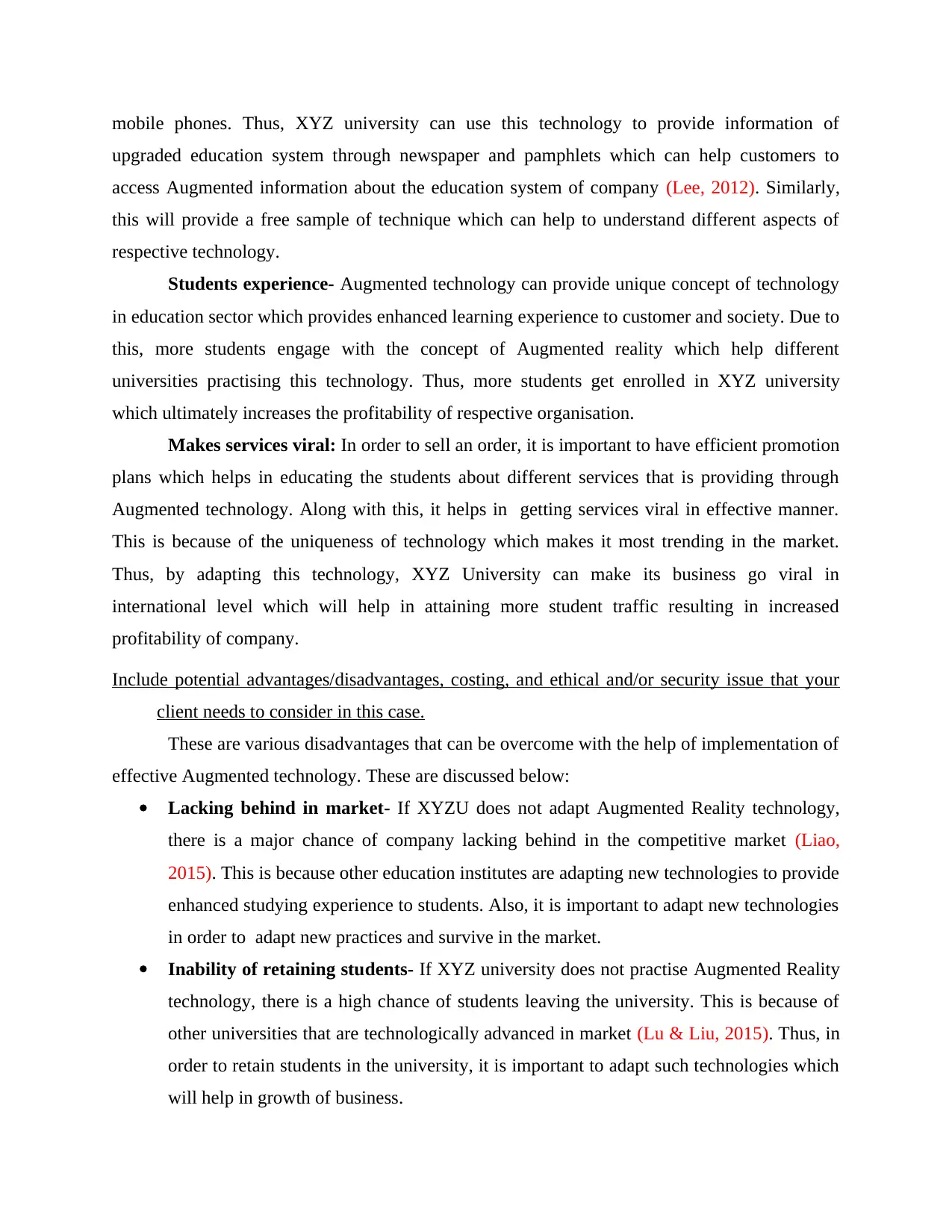
mobile phones. Thus, XYZ university can use this technology to provide information of
upgraded education system through newspaper and pamphlets which can help customers to
access Augmented information about the education system of company (Lee, 2012). Similarly,
this will provide a free sample of technique which can help to understand different aspects of
respective technology.
Students experience- Augmented technology can provide unique concept of technology
in education sector which provides enhanced learning experience to customer and society. Due to
this, more students engage with the concept of Augmented reality which help different
universities practising this technology. Thus, more students get enrolled in XYZ university
which ultimately increases the profitability of respective organisation.
Makes services viral: In order to sell an order, it is important to have efficient promotion
plans which helps in educating the students about different services that is providing through
Augmented technology. Along with this, it helps in getting services viral in effective manner.
This is because of the uniqueness of technology which makes it most trending in the market.
Thus, by adapting this technology, XYZ University can make its business go viral in
international level which will help in attaining more student traffic resulting in increased
profitability of company.
Include potential advantages/disadvantages, costing, and ethical and/or security issue that your
client needs to consider in this case.
These are various disadvantages that can be overcome with the help of implementation of
effective Augmented technology. These are discussed below:
Lacking behind in market- If XYZU does not adapt Augmented Reality technology,
there is a major chance of company lacking behind in the competitive market (Liao,
2015). This is because other education institutes are adapting new technologies to provide
enhanced studying experience to students. Also, it is important to adapt new technologies
in order to adapt new practices and survive in the market.
Inability of retaining students- If XYZ university does not practise Augmented Reality
technology, there is a high chance of students leaving the university. This is because of
other universities that are technologically advanced in market (Lu & Liu, 2015). Thus, in
order to retain students in the university, it is important to adapt such technologies which
will help in growth of business.
upgraded education system through newspaper and pamphlets which can help customers to
access Augmented information about the education system of company (Lee, 2012). Similarly,
this will provide a free sample of technique which can help to understand different aspects of
respective technology.
Students experience- Augmented technology can provide unique concept of technology
in education sector which provides enhanced learning experience to customer and society. Due to
this, more students engage with the concept of Augmented reality which help different
universities practising this technology. Thus, more students get enrolled in XYZ university
which ultimately increases the profitability of respective organisation.
Makes services viral: In order to sell an order, it is important to have efficient promotion
plans which helps in educating the students about different services that is providing through
Augmented technology. Along with this, it helps in getting services viral in effective manner.
This is because of the uniqueness of technology which makes it most trending in the market.
Thus, by adapting this technology, XYZ University can make its business go viral in
international level which will help in attaining more student traffic resulting in increased
profitability of company.
Include potential advantages/disadvantages, costing, and ethical and/or security issue that your
client needs to consider in this case.
These are various disadvantages that can be overcome with the help of implementation of
effective Augmented technology. These are discussed below:
Lacking behind in market- If XYZU does not adapt Augmented Reality technology,
there is a major chance of company lacking behind in the competitive market (Liao,
2015). This is because other education institutes are adapting new technologies to provide
enhanced studying experience to students. Also, it is important to adapt new technologies
in order to adapt new practices and survive in the market.
Inability of retaining students- If XYZ university does not practise Augmented Reality
technology, there is a high chance of students leaving the university. This is because of
other universities that are technologically advanced in market (Lu & Liu, 2015). Thus, in
order to retain students in the university, it is important to adapt such technologies which
will help in growth of business.
⊘ This is a preview!⊘
Do you want full access?
Subscribe today to unlock all pages.

Trusted by 1+ million students worldwide
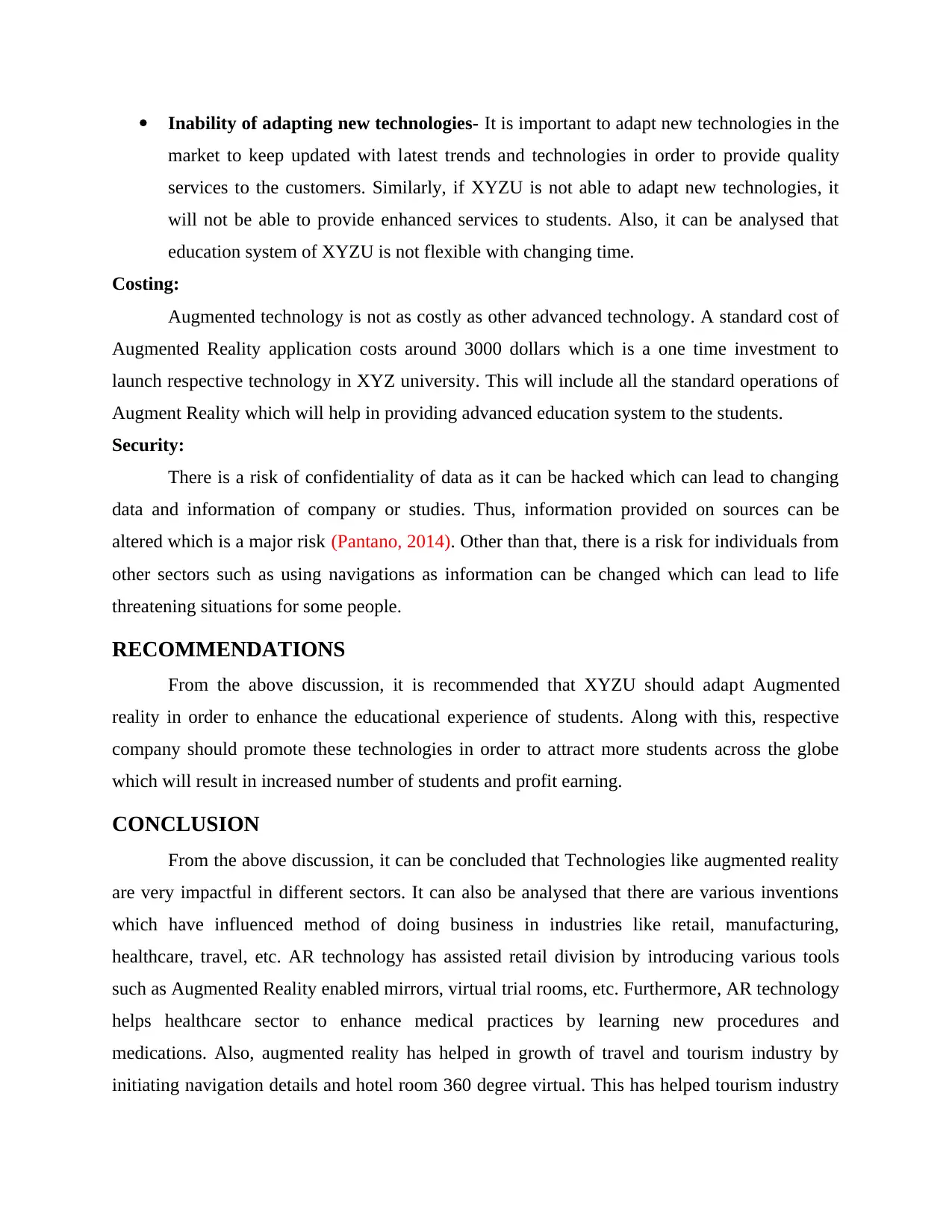
Inability of adapting new technologies- It is important to adapt new technologies in the
market to keep updated with latest trends and technologies in order to provide quality
services to the customers. Similarly, if XYZU is not able to adapt new technologies, it
will not be able to provide enhanced services to students. Also, it can be analysed that
education system of XYZU is not flexible with changing time.
Costing:
Augmented technology is not as costly as other advanced technology. A standard cost of
Augmented Reality application costs around 3000 dollars which is a one time investment to
launch respective technology in XYZ university. This will include all the standard operations of
Augment Reality which will help in providing advanced education system to the students.
Security:
There is a risk of confidentiality of data as it can be hacked which can lead to changing
data and information of company or studies. Thus, information provided on sources can be
altered which is a major risk (Pantano, 2014). Other than that, there is a risk for individuals from
other sectors such as using navigations as information can be changed which can lead to life
threatening situations for some people.
RECOMMENDATIONS
From the above discussion, it is recommended that XYZU should adapt Augmented
reality in order to enhance the educational experience of students. Along with this, respective
company should promote these technologies in order to attract more students across the globe
which will result in increased number of students and profit earning.
CONCLUSION
From the above discussion, it can be concluded that Technologies like augmented reality
are very impactful in different sectors. It can also be analysed that there are various inventions
which have influenced method of doing business in industries like retail, manufacturing,
healthcare, travel, etc. AR technology has assisted retail division by introducing various tools
such as Augmented Reality enabled mirrors, virtual trial rooms, etc. Furthermore, AR technology
helps healthcare sector to enhance medical practices by learning new procedures and
medications. Also, augmented reality has helped in growth of travel and tourism industry by
initiating navigation details and hotel room 360 degree virtual. This has helped tourism industry
market to keep updated with latest trends and technologies in order to provide quality
services to the customers. Similarly, if XYZU is not able to adapt new technologies, it
will not be able to provide enhanced services to students. Also, it can be analysed that
education system of XYZU is not flexible with changing time.
Costing:
Augmented technology is not as costly as other advanced technology. A standard cost of
Augmented Reality application costs around 3000 dollars which is a one time investment to
launch respective technology in XYZ university. This will include all the standard operations of
Augment Reality which will help in providing advanced education system to the students.
Security:
There is a risk of confidentiality of data as it can be hacked which can lead to changing
data and information of company or studies. Thus, information provided on sources can be
altered which is a major risk (Pantano, 2014). Other than that, there is a risk for individuals from
other sectors such as using navigations as information can be changed which can lead to life
threatening situations for some people.
RECOMMENDATIONS
From the above discussion, it is recommended that XYZU should adapt Augmented
reality in order to enhance the educational experience of students. Along with this, respective
company should promote these technologies in order to attract more students across the globe
which will result in increased number of students and profit earning.
CONCLUSION
From the above discussion, it can be concluded that Technologies like augmented reality
are very impactful in different sectors. It can also be analysed that there are various inventions
which have influenced method of doing business in industries like retail, manufacturing,
healthcare, travel, etc. AR technology has assisted retail division by introducing various tools
such as Augmented Reality enabled mirrors, virtual trial rooms, etc. Furthermore, AR technology
helps healthcare sector to enhance medical practices by learning new procedures and
medications. Also, augmented reality has helped in growth of travel and tourism industry by
initiating navigation details and hotel room 360 degree virtual. This has helped tourism industry
Paraphrase This Document
Need a fresh take? Get an instant paraphrase of this document with our AI Paraphraser
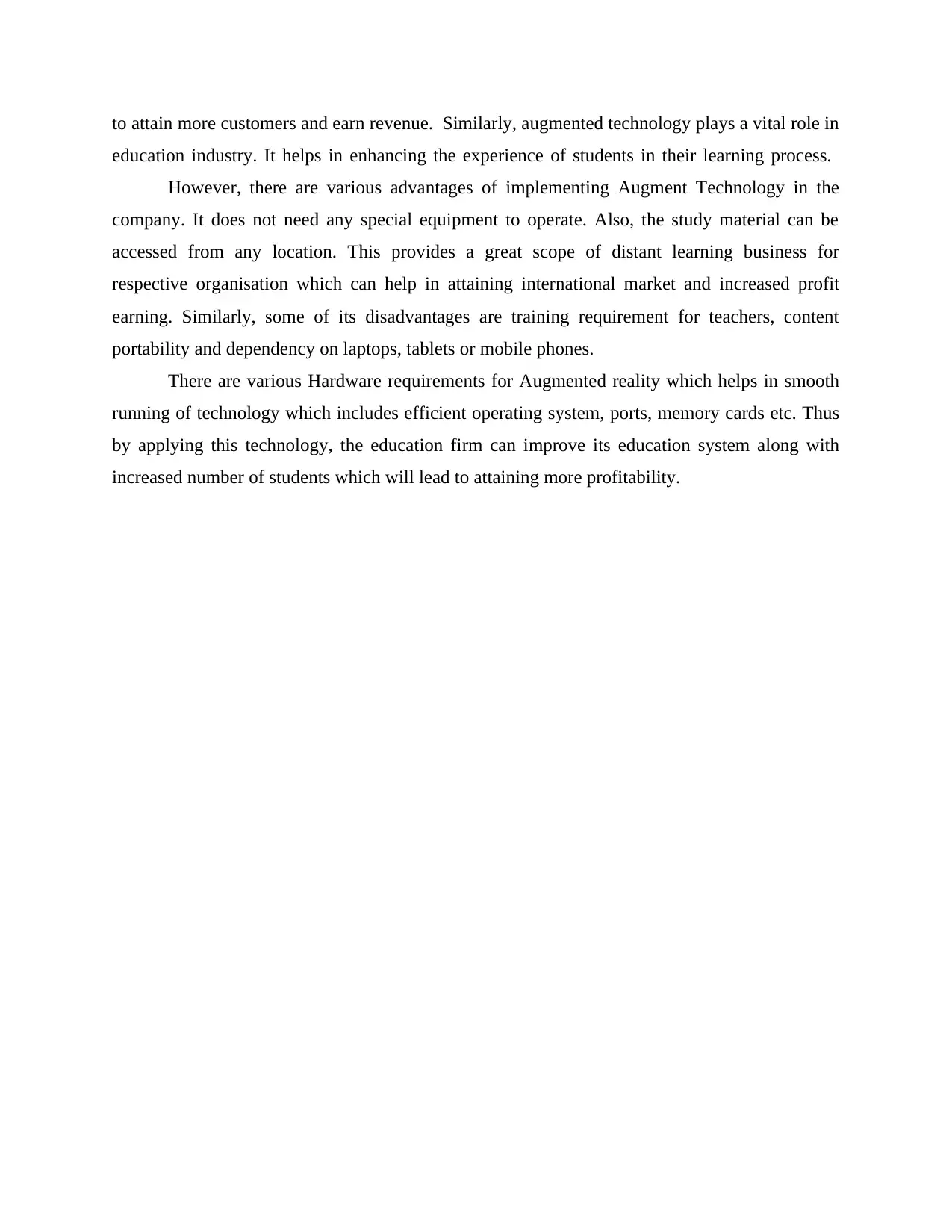
to attain more customers and earn revenue. Similarly, augmented technology plays a vital role in
education industry. It helps in enhancing the experience of students in their learning process.
However, there are various advantages of implementing Augment Technology in the
company. It does not need any special equipment to operate. Also, the study material can be
accessed from any location. This provides a great scope of distant learning business for
respective organisation which can help in attaining international market and increased profit
earning. Similarly, some of its disadvantages are training requirement for teachers, content
portability and dependency on laptops, tablets or mobile phones.
There are various Hardware requirements for Augmented reality which helps in smooth
running of technology which includes efficient operating system, ports, memory cards etc. Thus
by applying this technology, the education firm can improve its education system along with
increased number of students which will lead to attaining more profitability.
education industry. It helps in enhancing the experience of students in their learning process.
However, there are various advantages of implementing Augment Technology in the
company. It does not need any special equipment to operate. Also, the study material can be
accessed from any location. This provides a great scope of distant learning business for
respective organisation which can help in attaining international market and increased profit
earning. Similarly, some of its disadvantages are training requirement for teachers, content
portability and dependency on laptops, tablets or mobile phones.
There are various Hardware requirements for Augmented reality which helps in smooth
running of technology which includes efficient operating system, ports, memory cards etc. Thus
by applying this technology, the education firm can improve its education system along with
increased number of students which will lead to attaining more profitability.
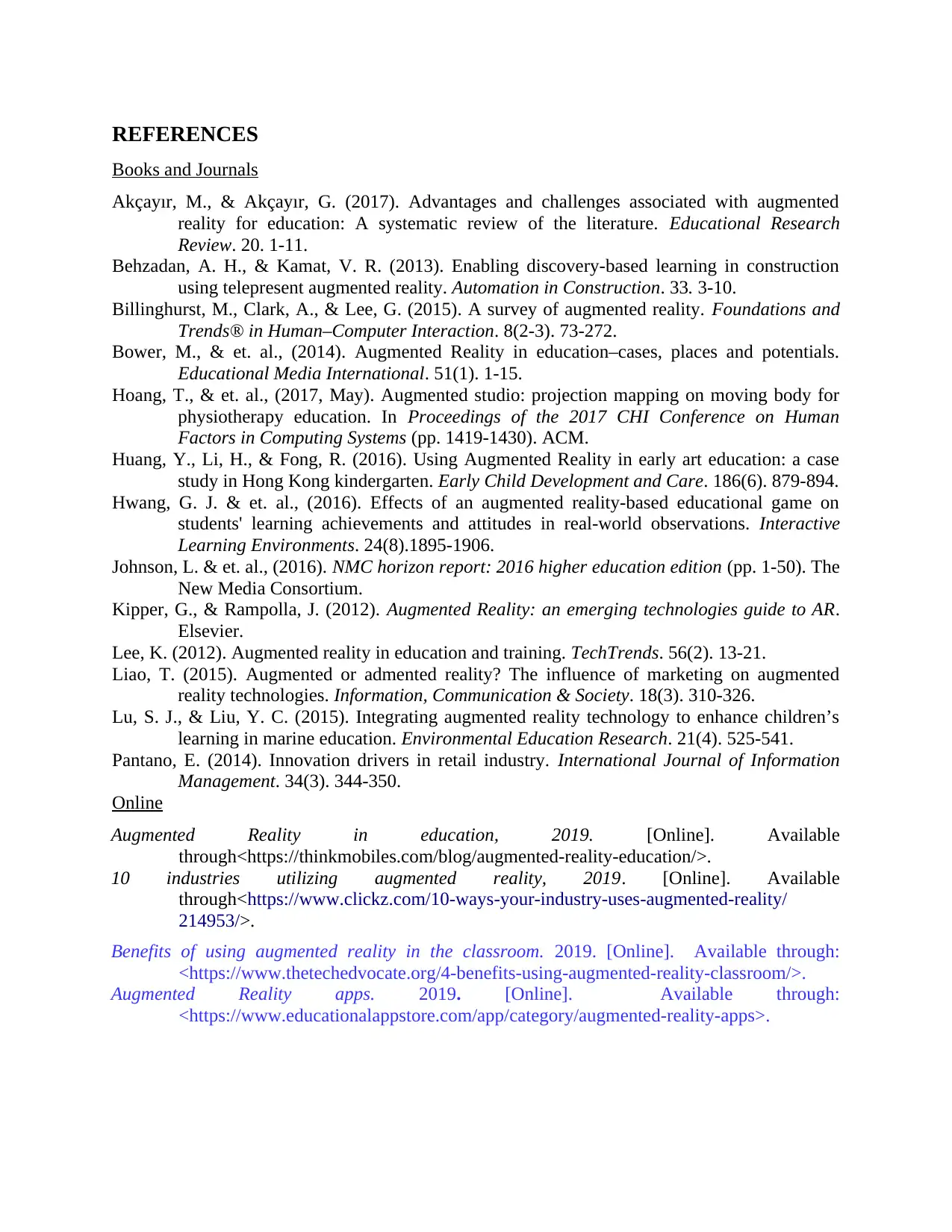
REFERENCES
Books and Journals
Akçayır, M., & Akçayır, G. (2017). Advantages and challenges associated with augmented
reality for education: A systematic review of the literature. Educational Research
Review. 20. 1-11.
Behzadan, A. H., & Kamat, V. R. (2013). Enabling discovery‐based learning in construction
using telepresent augmented reality. Automation in Construction. 33. 3-10.
Billinghurst, M., Clark, A., & Lee, G. (2015). A survey of augmented reality. Foundations and
Trends® in Human–Computer Interaction. 8(2-3). 73-272.
Bower, M., & et. al., (2014). Augmented Reality in education–cases, places and potentials.
Educational Media International. 51(1). 1-15.
Hoang, T., & et. al., (2017, May). Augmented studio: projection mapping on moving body for
physiotherapy education. In Proceedings of the 2017 CHI Conference on Human
Factors in Computing Systems (pp. 1419-1430). ACM.
Huang, Y., Li, H., & Fong, R. (2016). Using Augmented Reality in early art education: a case
study in Hong Kong kindergarten. Early Child Development and Care. 186(6). 879-894.
Hwang, G. J. & et. al., (2016). Effects of an augmented reality-based educational game on
students' learning achievements and attitudes in real-world observations. Interactive
Learning Environments. 24(8).1895-1906.
Johnson, L. & et. al., (2016). NMC horizon report: 2016 higher education edition (pp. 1-50). The
New Media Consortium.
Kipper, G., & Rampolla, J. (2012). Augmented Reality: an emerging technologies guide to AR.
Elsevier.
Lee, K. (2012). Augmented reality in education and training. TechTrends. 56(2). 13-21.
Liao, T. (2015). Augmented or admented reality? The influence of marketing on augmented
reality technologies. Information, Communication & Society. 18(3). 310-326.
Lu, S. J., & Liu, Y. C. (2015). Integrating augmented reality technology to enhance children’s
learning in marine education. Environmental Education Research. 21(4). 525-541.
Pantano, E. (2014). Innovation drivers in retail industry. International Journal of Information
Management. 34(3). 344-350.
Online
Augmented Reality in education, 2019. [Online]. Available
through<https://thinkmobiles.com/blog/augmented-reality-education/>.
10 industries utilizing augmented reality, 2019. [Online]. Available
through<https://www.clickz.com/10-ways-your-industry-uses-augmented-reality/
214953/>.
Benefits of using augmented reality in the classroom. 2019. [Online]. Available through:
<https://www.thetechedvocate.org/4-benefits-using-augmented-reality-classroom/>.
Augmented Reality apps. 2019. [Online]. Available through:
<https://www.educationalappstore.com/app/category/augmented-reality-apps>.
Books and Journals
Akçayır, M., & Akçayır, G. (2017). Advantages and challenges associated with augmented
reality for education: A systematic review of the literature. Educational Research
Review. 20. 1-11.
Behzadan, A. H., & Kamat, V. R. (2013). Enabling discovery‐based learning in construction
using telepresent augmented reality. Automation in Construction. 33. 3-10.
Billinghurst, M., Clark, A., & Lee, G. (2015). A survey of augmented reality. Foundations and
Trends® in Human–Computer Interaction. 8(2-3). 73-272.
Bower, M., & et. al., (2014). Augmented Reality in education–cases, places and potentials.
Educational Media International. 51(1). 1-15.
Hoang, T., & et. al., (2017, May). Augmented studio: projection mapping on moving body for
physiotherapy education. In Proceedings of the 2017 CHI Conference on Human
Factors in Computing Systems (pp. 1419-1430). ACM.
Huang, Y., Li, H., & Fong, R. (2016). Using Augmented Reality in early art education: a case
study in Hong Kong kindergarten. Early Child Development and Care. 186(6). 879-894.
Hwang, G. J. & et. al., (2016). Effects of an augmented reality-based educational game on
students' learning achievements and attitudes in real-world observations. Interactive
Learning Environments. 24(8).1895-1906.
Johnson, L. & et. al., (2016). NMC horizon report: 2016 higher education edition (pp. 1-50). The
New Media Consortium.
Kipper, G., & Rampolla, J. (2012). Augmented Reality: an emerging technologies guide to AR.
Elsevier.
Lee, K. (2012). Augmented reality in education and training. TechTrends. 56(2). 13-21.
Liao, T. (2015). Augmented or admented reality? The influence of marketing on augmented
reality technologies. Information, Communication & Society. 18(3). 310-326.
Lu, S. J., & Liu, Y. C. (2015). Integrating augmented reality technology to enhance children’s
learning in marine education. Environmental Education Research. 21(4). 525-541.
Pantano, E. (2014). Innovation drivers in retail industry. International Journal of Information
Management. 34(3). 344-350.
Online
Augmented Reality in education, 2019. [Online]. Available
through<https://thinkmobiles.com/blog/augmented-reality-education/>.
10 industries utilizing augmented reality, 2019. [Online]. Available
through<https://www.clickz.com/10-ways-your-industry-uses-augmented-reality/
214953/>.
Benefits of using augmented reality in the classroom. 2019. [Online]. Available through:
<https://www.thetechedvocate.org/4-benefits-using-augmented-reality-classroom/>.
Augmented Reality apps. 2019. [Online]. Available through:
<https://www.educationalappstore.com/app/category/augmented-reality-apps>.
⊘ This is a preview!⊘
Do you want full access?
Subscribe today to unlock all pages.

Trusted by 1+ million students worldwide
1 out of 12
Related Documents
Your All-in-One AI-Powered Toolkit for Academic Success.
+13062052269
info@desklib.com
Available 24*7 on WhatsApp / Email
![[object Object]](/_next/static/media/star-bottom.7253800d.svg)
Unlock your academic potential
Copyright © 2020–2025 A2Z Services. All Rights Reserved. Developed and managed by ZUCOL.





